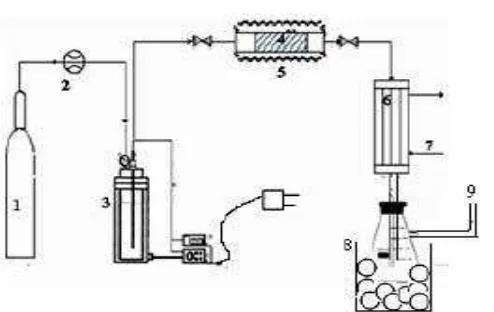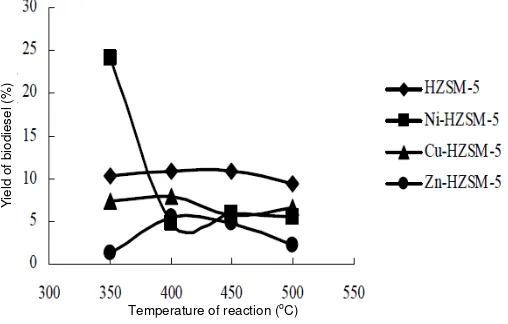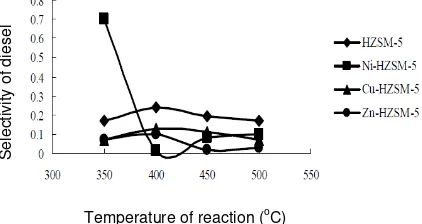The Catalyst Selectivity to Cracking Product of Palm Oil
Achmad Roesyadi, Danawati Hariprajitno, Nurjannah, Santi Dyah Savitri
Chemical Reaction Engineering Laboratory
Department Of Chemical Engineering Department Of Chemical Engineering Sepuluh November Institute of Technology, Surabaya, Indonesia 60 111 E-mail : [email protected]
Abstract :
It is important to develop a renewable source of energy to overcome a limited source fossil energy. Palm oil is a potential alternative and environmental friendly energy resource in Indonesia due to high production capacity of this vegetable oil. The research studied effect of catalyst to selectivity of biofuel product from cracking of palm oil. The catalyst consists of silica alumina and synthesized HZSM-5 catalyst, with or without support. The research was conducted in two steps, namely catalyst synthesized and catalytic cracking process. HZSM-5 was synthesized using Plank methods. The analysis of the synthesized catalysts use AAS (Atomis Absorption Spectroscopy), BET (Brunaueur Emmet Teller). The cracking was carried out in a fixed bed microreactor with diameter of 1 cm and length of 16 cm which was filled with 0,6 gram catalyst. Composition of product if using HZSM-5 catalyst are gasoline of 28,87%; kerosene of 16,70% and diesel of 12,20%. Using silica alumina catalyst give product distribution such as diesel of 32,05% and gasoline of 2,78%.
Keywords: biofuel, catalytic cracking, HZSM-5, palm oil, silica alumina
1. Introduction
Economic growth, population, development of the area and development push will need more energy. Energy needs are met during this ingredients from renewable not namely petroleum and coal. However the energy reserves is not always able to meet the entire energy needs in the long term. In anticipation of that condition, it needs to be developed alternative energy from renewable materials. Therefore, this research to develop alternative energy from renewable materials to replace the role of fuel or coal.
Renewable energy sources derived from vegetable oils or animal fats. Some vegetable oils have been developed as alternative energy, among others, palm oil, jatropha oil, soy bean oil and so on. Indonesia's palm oil-producing countries is the second largest in the world. The production of palm oil in Indonesia is 12 million tons/year in 2010. Therefore, palm oil is one of the potential raw material for making biofuels. Palm oil has the advantage of more environmentally friendly because it is free of nitrogen and sulfur.
Various processes have been made to produce biofuels. Cracking without catalyst (thermal cracking) take place at high temperature and pressure that requires great energy. Catalytic cracking is a way to solve the long carbon chain is long enough to a simple carbon chain molecule with the aid of a catalyst. The function of catalyst is reducing the activation energy of the substance. Catalyst also control the selectivity of the product. The production of biofuels research was developed through catalytic cracking with different types of catalyst. The purpose of this research was to study the influence of catalyst to biofuel product selectivity.
Palm oil production is on the rise and the cost of production of palm oil is relatively lower than other plant oils. Indonesia as a country of tropical land that still has a quite extensive may be large to be developed both through capital investment and foreign scale plantation of the people. Palm oil contain fatty acids vary, both saturated and saturated, as in Table 1.
Schwab, et al., (1999) studied the mechanism of the thermal decomposition of triglycerides and distillation with an air sparger and nitrogen by means of distillation ASTM standard. According to Pioch, et al (1993) that the catalytic cracking of copra oil and coconut oil using a standard catalyst of petroleum (SiO2/Al2O3) at 450oC produce gas, liquid and solid with lower molecular weights. The superheated organic column produced biogasoline and biodiesel in fractionation column. Vonghia, et al., (1995) proposed that the initial cracking occurs via two
e ha is s of displa e e t are β-eli i atio da ϒ-hidrogen. Leng, et al, (1999) using a fixed bed reactor to cracking palm oil by Catalyst of HZSM-5. Conversion of Palm oil is lower than canola oil, in which nearly 100% conversion [3].
Table 1. Composition of fatty acid in palm oil
The two tipe of catalyst were synthesized include HZSM-5 without impregnation and HZSM-5 impregnated by a solution of CuSO4.5H2O, NiSO4.7H2O and ZnSO4.7H2O. This research consisted of catalyst preparation, cracking
a d a alysis of results. Catalysts i preg atio used the Ro ero’s pro edure 1 . H)“M-5 catalyst calcinated on an oven at 110oC for 2 hours, and cooling in the desiccators. Catalytic cracking was done in a microreactor fixed bed with diameter of 1 cm, length of 16.4 cm and was filled with 0.6 g of catalyst in Figure 1. Temperature of cracking carried was 350 - 500oC and flow rate N2 was 120-160 ml/minute. The result analyzed by gas
chromatography of FID (Flame Ionization Detector).
2.2. Cracking of palm oil.
Catalytic cracking done in a microreactor coating by heater and 1 g weight of catalyst. Palm input in reactor at 350oC, then the tank are flowed by nitrogen gas with rate of 100-160 ml/min. The oil vapor and nitrogen gas flowed into the fixed bed at temperature of 350 to 500oC. Catalytic cracking was carried out during the 120 minutes. The result analyzed by gas chromatography method of FID (Flame Ionization Detector) column HP PORAPLOT QO4. The equipment of cracking can be seen in Figure 1.
3. Result and Discussion.
3.1. Characterization of of catalyst
(1) Flow rater of N2 , (2) Flow meter , (3) heater, (4) catalyst , (5) microreactor, (6) condensor , (7) Cooling water, (8) sample of liquid, (9) sample of gas
Figure 1. Reactor for cracking palm oil
Minimum pore size length of catalyst was 8oA and surface area is more than 100 m2/g. [6]. Surface area increased by the addition few metal, because the surface was covered by a metal catalyst. The reducing of surface
area did ’t ea the reducing of the catalyst effectiveness, but adding of the active site affected the rate of the reaction [7].
3.2. Influence of temperature on yield gasoline, kerosene and diesel with HZSM-5 catalyst without impregnation
and with impregnation metal of Ni, Cu and Zn
The purpose of active metal impregnation on catalyst surface added the active side on the catalyst surface, so the activity of the catalyst increased. Figure 2 to 4 showed the influence of temperature on yield of biofuels by catalyst with or without impregnation. The influence of activity catalyst was done by flow rate of N2 gas is 130
ml/min and variations of temperature. Figure 2 shows that the highest yield of gasoline is obtained by HZSM-5 catalyst/Ni on temperature of 450oC is 29,38%. This is due to Ni metal impregnation to HZSM-5 catalyst distributed evenly on the surface of the metal, so the active site catalysts having increased. Increasing of the active site followed increasing of yield of gasoline.
Figure 3 showed the highest yield of the kerosene was obtained by HZSM-5 Ni-catalyst on temperature of 500oC at 14.95%. Figure 4 showed the highest yield of the diesel was obtained by HZSM-5 catalyst at 24.19%. From of the three types of impregnation catalyst, only the catalyst of HZSM-5/Ni which increased in yield with the inclusion of metal catalyst of Ni on HZSM-5.
Temperature of reaction (oC)
Yi
e
ld
o
f
g
a
so
lin
e
(%
)
Temperature of reaction (o C)
Yi
e
ld
o
f
ke
ro
se
n
e
(%
)
Figure 3. The influence of reaction temperature on yield of kerosene at N2 flow rate of 130 ml/min
Temperature of reaction (o C)
Yi
e
ld
o
f
b
io
d
ie
se
l
(%
)
Figure 4. The influence of reaction temperature on yield of diesel for flow rate N2 of 130 ml/min
3.3. Influence of temperature on the selectivity of gasoline, kerosene and diesel for Ni/Cu/Zn-HZSM-5 catalyst
Temperature of reaction (oC)
Se
le
ct
ivi
ty
o
f
g
a
so
lin
e
Figure 5. The influence of reaction temperature on selectivity of gasoline for flow rate N2 of 130 ml/menit
Temperature of reaction (oC)
Se
le
ct
ivi
ty
o
f
ke
ro
se
n
e
Figure 6. The influence of reaction temperature on selectivity of kerosene for flow rate N2 of 130 ml/menit
Se
le
ct
ivi
ty
o
f
d
ie
se
l
Temperature of reaction (oC)
Figure 7. The influence of reaction temperature to selectivity of diesel for flow rate N2 of 130 ml/menit
4. Conclusion
Cracking product of vegetable oil was more friendly than cracking product of crude oil. Using of HZSM-5 catalyst with or without impregnation decrease activation energy of cracking reaction. The result of characteristic catalyst that the surface area and pore size suitable with the criteria of a standard catalyst. The product distribution at reactor temperature of 450oC and rate of N2 gas of 130 ml/min by catalyst HZSM-5 were 17,11% of
gasoline, 14,89% of kerosene and 10,86% of diesel. For the same condition by catalyst Ni/HZSM-5 were 17,55% of gasoline, 13,48% of kerosene and 5,84% of diesel. And then by catalyst Cu/HZSM-5 were 18,05% of gasoline,
References
[1] Pioch D, Lazao P, Rasoanatoandro MC, Graille J, Geneste P, Guida A. 1993. Biofuel from Catalytic Cracking of Tropical Vegetable Oils. oleagineux 48. p. 289-291.
[2] Vonghia E, Boocock DGB, Konar SK, Leung A. 1995. Pathway for the deoxygenation of triglicerides to aliphatic hydrocarbons over activated alumina. Energy Fuel 9 : 1010 – 1096
[3] Leng TY, Mohhamad AR, Bahtia S. 1999. Catalytic conversion of palm oil to fuels and chemicals. Canad J Chem Eng 77:1-15.
[4] Schwab AW, Dykstra GJ, “elke E, “ore so , “.C. a d Pryde, E.H. 1 , Diesel Fuel fro De o positio Ther al of
“oy ea s Oil , JAO“ , 1 1 – 1786.
[5] Bekkum VH, Flaningen EM, and Jansen JC. 1991. Introduction to Zeolite Science and Practice. New York.
[6] Hui YH. 1 . Bailey’s I dustrial Oil a d Fat Produ ts : I dustrial a s Co su er No Edi le Produ t fro Oil a d fats. vol. 5. 5th ed. John Wiley & Sons. New York.
[7] Fogler H, Scott. 1999. Elements of Chemical Reaction Engineering 3rd ed. Prentice Hall International Series in the Physical and Chemical Engineering Series.



